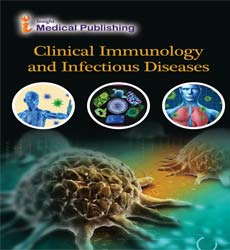Market Analysis of Allergy 2020
Ali
South Valley University, Egypt, E-mail: alin@yahoo.com
With the coordination of the Organizing Committee, we are gratified to framework the program for the 15th International Conference on Allergy and Clinical Immunology, August, 2020 in Dubai, UAE. The Allergy 2020 will be organized encompassing the theme “Cracking the code on Allergies & Immune Disorders". Allergy 2020 is comprehended of 15 tracks designed to offer widespread sessions that directs current issues in Allergy & Immunological research affairs.
Millions of individuals across the globe are affected by allergy and immune disorders – some are minor and others are critical. As per World Health Organization (W.H.O) research, more than 17.5 million people have asthma, an estimated 31% of all deaths worldwide and 80% of all asthma deaths are due to hypersensitivity. According to the market study, the global market for Immune disorders is expected to grow from $13.7 billion to $18.2 billion by 2020. An extreme part of research is going on Allergy and Immunology in the top Universities across the globe. Many companies are associated with various diagnostic instruments and other therapeutics. Besides these various universities and companies, societies and research labs are also associated in this research field.
Throughout the globe the research and market on Allergy and Immunology is trending with large number of researchers, scientists and doctors from several hospitals, universities, labs and communities engaging in the field. It will be a great opportunity for individuals from this respective field to participate in this Allergy and Clinical Immunology Conference which will conduct demonstrations, distribute information, allow networking with current and potential researchers and give name recognition. The 2 days event will highlight world-renowned speakers, the most recent techniques, tactics, and the newest updates in Immunology field.
The weather, food and lifestyle habits in UAE increases the evidence of allergies and immune disorders mainly allergic rhinitis, allergic asthma, Allergic conjunctivitis and food allergy among children in huge number and in adults to a lesser extent. This leads to increase in market share of allergen products and immunotherapy devices in UAE. The graph shows the market growth of therapeutic solutions and products for allergy and immune disorders

The increase in allergy and immune disorders has widened the immunology research in different segments and brought forward several companies, institutes, hospitals and doctors from different fields of biology like paediatrics, cellular biology, pathology etc. The role and contribution of different members can be seen in the following graph

Allergic diseases include anaphylaxis, food allergies, forms of asthma, conjunctivitis, eczema, eosinophilic disorders, and drug and insect allergies. According to the International Study of Asthma and Allergies in Childhood (ISAAC), an estimated hay fever prevalence in 13 to 14 year old children was approximately 22.1% globally, with 29.5% in Africa, 23.9% in Asia, 15.8% in the Indian subcontinent, 23.7% in Latin America, 33.3% in North America, 12.3% in Northern and Eastern Europe, 39.8% in the Oceania, and 21.2% in the Western Europe. It is essential for patients to receive an accurate diagnosis of hay fever. In addition, food allergies are on the rise.
An estimated 17 million Europeans have food allergies, and according to European Academy of Allergy and Clinical Immunology (EAACI), over the past decade, hospital admissions for severe allergic reactions in children have risen seven-fold. In the United States, according to the CDC report, food allergies result in more than 300,000 ambulatory-care visits each year among children less than 18 years of age. Therefore, with the growing incidences of allergic diseases, the new diagnostic market for the same is expected to grow at a good pace. Furthermore, the latest diagnostic strategies for allergies and research on new approaches for treatment are expected to drive the market.
The global allergy treatment market was valued at $24,653.4 million in 2017 and is expected to reach $40,360.2 million by 2025, registering a CAGR of 6.3% from 2018 to 2025. An allergy is a condition caused by hypersensitivity of the immune system to typically harmless substances, often referred to as allergens, in the environment. Allergens can include aeroallergens such as dust mite, mold, tree weed, grass pollen, milk, egg, soy, wheat, and others. These allergens can cause various allergic disease conditions including hay fever or allergic rhinitis, asthma, atopic dermatitis, and others. The major symptoms of allergic reactions include itching in the nose, roof of the mouth, throat, or eyes as well as sneezing, stuffy nose (congestion), teary eyes, and others. In addition, food allergies can cause symptoms such as vomiting, diarrhea, or respiratory symptoms, after ingestion of an allergen. According to the WHO, allergies are the fourth largest global pathology condition after cancer, AIDS, and cardiovascular diseases.
The rhinitis allergy segment was the highest contributor to the market in 2017, and is anticipated to maintain its dominance throughout the forecast period. This was attributed to the increase in prevalence of allergic rhinitis across the globe. For instance, according to the European Academy of Allergy and Clinical Immunology (EAACI), in 2017, around 400 million people suffered from rhinitis worldwide.

Based on treatment, the allergy treatment market is classified into anti-allergy drugs and immunotherapy. The anti-allergy drugs segment accounted for the highest revenue in 2017 and is expected to maintain its dominance throughout the forecast period. This is attributed to the convenience of self-administration, compactness, and easy manufacturing of oral dosage forms.
Contact:
James Austinallergy@memeetings.com
Open Access Journals
- Aquaculture & Veterinary Science
- Chemistry & Chemical Sciences
- Clinical Sciences
- Engineering
- General Science
- Genetics & Molecular Biology
- Health Care & Nursing
- Immunology & Microbiology
- Materials Science
- Mathematics & Physics
- Medical Sciences
- Neurology & Psychiatry
- Oncology & Cancer Science
- Pharmaceutical Sciences
